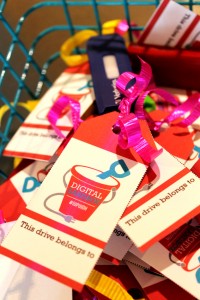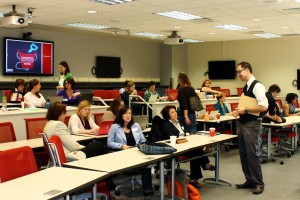Digital Sandbox: Building a community of digital humanists
10 January 2014 – Nicholas Sacco
digital media, methods, digital history, collaboration, education, training, graduate students, new professionals

Each participant in the Digital Sandbox workshop received a flash drive containing supplementary materials for each session. Photo credit: Christine Crosby
There is a misconception in our American culture that young professionals are proficient at using technology. However, discussions among historians, humanists, and prospective employers indicate that many public history graduates are entering the field without practical training or consideration of the complex intersection between digital technology and public history.
Indeed, one study found that only 36% of public history programs are actively “preparing their students to create or author digital history or new media resources.” In a recent History@Work post, Robert Weyeneth expounded upon this lack of digital literacy among graduate students as just one part of a “perfect storm” that threatens the field of public history. The concerns he expresses are legitimate. As graduate students, we understand that we are emerging as public history professionals in the midst of a remarkable digital transformation. If we do not commit to attaining at least a basic level of technological proficiency, we will be left behind.
Last spring, the Indiana University-Purdue University Indianapolis (IUPUI) History Department offered its first graduate seminar on the digital humanities. During this class, we saw firsthand the challenges of fitting both the theory and practical skills necessary for digital literacy into a fifteen-week class. With the foundation and momentum from that seminar, the four of us took the initiative to take digital humanities out of the classroom and into the “sandbox” – a place where fellow students could explore and learn together.
What resulted was Digital Sandbox, a day-long workshop in the digital humanities, planned and facilitated by students. Our first step was to gather ideas for topics from our peers and bring together classmates, professors, and community members from across the state with expertise in various areas of digital technology. We sought to create a participatory experience, one that would provide conversation and experimentation with hands-on digital tools that could be integrated into students’ class work and research projects. Sessions fell into several categories:
- Tools to improve research through the integration of digital programs into student work. Examples included sessions on Zotero, Excel, and WordPress.
- Networking and promoting research through social media both professionally and academically. Local humanities professionals demonstrated how they use social media to engage local communities, and current doctoral students and recent PhDs discussed how they are using digital tools to enhance and present their research.
- Ongoing projects within our university community and beyond. One session showcased the IUPUI Polis Center’s Digital Atlas of American Religion, demonstrating how humanities research can be presented visually using Geographic Information Systems (GIS) software. Another session encouraged participants to contribute edits to humanities articles on Wikipedia through a “nuts and bolts” training session.

Participants gathering before a session at the Digital Sandbox workshop. Photo credit: Christine Crosby
As with all projects, we had successes, but our vision fell short in some ways. Many sessions ended up more lecture-based than participatory. And although we were able to include about forty students across three disciplines – public history, library science, and museum studies – our ideal workshop would have brought together a wider range of disciplines. Despite these shortcomings, the workshop succeeded in raising awareness about digital humanities on our campus, and we hope this awareness will continue to increase in the future. We recognize that with the lifespan of a student in our master’s program lasting less than three years, turnover is quick, and there is little time to focus on workshop planning amidst a full class load and thesis writing. An intentional push by both students and professors to incorporate digital humanities into our program will be necessary to maintain the momentum that our workshop began.
We are encouraged that a conversation that could have ended with a class of ten students last spring grew into a larger dialogue with more diverse participants. We are not sure what comes next: it is possible the workshop will continue in the future or that incoming students will have new, innovative ideas of how to further the discussion. As we collect feedback, we are interested in hearing thoughts from our larger community:
- Are there conversations about digital humanities occurring on your campuses? What types of projects have you undertaken?
- Should public history programs do more to teach their students about the digital humanities? How best might this be done?
~ Christine Crosby, Abby Curtin, Callie McCune, and Nick Sacco are second-year public history graduate students at Indiana University-Purdue University Indianapolis.




I applaud your initiative! I think that many faculty members, including myself, although I am new, have quite a bit of catching up to do when it comes to the digital humanities. It just isn’t possible for all programs to have courses in this at this point. I know that you all were part of a class, but the initiative that you took to both learn something that you wanted to learn and to teach each other the things you already knew is essential. Even without a class, yours is a model that other students can take and modify to fit their needs.
On the other hand, just as many students and professors are intimidated by digital history/digital humanities, many of those professors have actually been doing it–at least on the input side–for a long time. They still have things they can teach students and ways to integrate digital skills into their classrooms. I would also encourage students to reach out to their librarians and to others in the humanities on campus. Some of the best work in the digital humanities is coming out of English departments; see if they are offering their students a course already and if it can be crosslisted.
I have also found a surprising level of pushback from students (both graduate and undergraduate) when I have tried to do some digital projects. I have had students tell me that they hate certain technology/tools and will only use the minimum to get the grade. There is such a wide variety of digital proficiency in the students in my classes that I never know how successful a particular project will be. Much of that success depends on a student’s willingness to spend time catching up and to overcome the blocks they have to using certain tools (whether mental blocks or knowledge gaps).
In light of this, how do we convince students in classes that aren’t called digital history or digital humanities to buy in to learning these technologies and skills?
Hi Kristen, thank you for the thoughtful comment and for the kind words about Digital Sandbox.
I agree with you that for many programs, questions of resources necessarily emerge. Not every public history program has professors who feel comfortable running a digital history/digital humanities course or have resources on hand that could be used for that purpose. Digital Sandbox was a way for the four of us to not only show digital tools and skills to our fellow classmates, but to also demonstrate to the history faculty that we are committed to learning more about the digital humanities and how it impacts our scholarship as public historians.
It is true that most history departments will have a number of both students and teachers resistant to the use of digital technology or the creation of born-digital scholarship. Regarding students, I believe it’s important that professors realize that there is no such thing as a “digital native,” just like there was no such thing as a “television native” fifty years ago. Just because a student uses their phone and/or computer to communicate or surf the web does not mean that they understand how that technology works. Jenny Emanuel, Digital Services & Reference Librarian at the University of Illinois, Urbana, recently conducted a study concluding that while younger students are more comfortable using digital technology, they are no more comfortable than established professionals at actually creating digital software tools, hardware programs, or born-digital scholarship. In sum, many students are consumers of digital technology, not creators. These distinctions are important for professors to keep in mind as they work with students who may or may not readily embrace digital history/digital humanities. Having librarians and other associated faculty help these students outside the classroom is an excellent suggestion on your part.
Finally, I would argue that in order for students to “buy-in” to the digital landscape and its scholarly opportunities, their professors also have to “buy-in” and demonstrate the importance of digital literacy to their students’ professional goals. Not all students will be convinced, of course, but the professorial “buy-in” is crucial. For universities who have digital humanities professors and experts on staff, I believe the teaching of digital literacy also needs to extend to fellow colleagues, not just students. Not every history professor needs to have a digital background, but every history professor should make an effort to acquaint themselves with some aspect of digital methodology, just as all history professors should acquaint themselves with public history practices and methodologies.